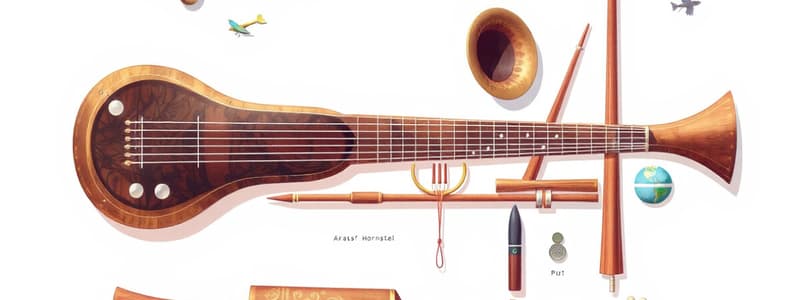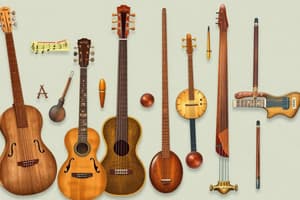Podcast
Questions and Answers
What is the Sachs-Hornbostel system of classification based on?
What is the Sachs-Hornbostel system of classification based on?
- The size of the instrument
- How an instrument produces sound (correct)
- The materials used in the instrument
- The genre of music
What are aerophones?
What are aerophones?
Instruments that produce sounds via vibrating columns of air.
What are membranophones?
What are membranophones?
Instruments that produce sounds via vibrating, stretched membranes.
What is a chordophone?
What is a chordophone?
Define idiophones.
Define idiophones.
What are electrophones?
What are electrophones?
What does pitch refer to?
What does pitch refer to?
What is the definition of timbre?
What is the definition of timbre?
What is the pulse in music?
What is the pulse in music?
What does meter refer to in music?
What does meter refer to in music?
What is the form of a piece of music?
What is the form of a piece of music?
Define texture in music.
Define texture in music.
What is monophonic texture?
What is monophonic texture?
What is polyphonic texture?
What is polyphonic texture?
What is homophonic texture?
What is homophonic texture?
What does melody and accompaniment refer to?
What does melody and accompaniment refer to?
What is melody and drone?
What is melody and drone?
What is music as flow?
What is music as flow?
What is semiotics?
What is semiotics?
What is a sign?
What is a sign?
What does the term object refer to in semiotics?
What does the term object refer to in semiotics?
What does effect mean in the context of semiotics?
What does effect mean in the context of semiotics?
What is an icon?
What is an icon?
What does the index indicate?
What does the index indicate?
What are symbols in semiotics?
What are symbols in semiotics?
What is semiotic density?
What is semiotic density?
What is participatory performance?
What is participatory performance?
Flashcards are hidden until you start studying
Study Notes
Sachs-Hornbostel System
- Classifies musical instruments based on vibrations producing sound.
- Divides instruments into four main groups: aerophones, chordophones, idiophones, and membranophones.
Aerophones
- Produce sound through vibrating air columns, e.g., flutes and trumpets.
- Sound is generated without strings or membranes; relies solely on air action.
Membranophones
- Instruments that create sound via vibrating stretched membranes, like drums.
- Can be played by striking or rubbing the membranes.
Chordophones
- Produce sound through vibrating strings between two points.
- Examples include violins, guitars, and harps.
Idiophones
- Generate sound through the whole instrument vibrating, without strings or membranes.
- Common examples are gongs and xylophones.
Electrophones
- Instruments that use electrical means to generate sound.
- Includes devices like synthesizers and drum machines.
Pitch
- Refers to the perceived highness or lowness of a tone, determined by its frequency.
Timbre (Tone Colour)
- Refers to the quality or character of a sound, distinguishing different types of sound production.
Pulse
- The underlying beat that provides a framework for the music.
Meter
- Describes the rhythmic structure and organization of beats in music.
Form
- The overall layout or structure of a musical composition divided into sections.
Texture
- Describes how melodic, rhythmic, and harmonic materials combine to shape the sound quality.
- Types include monophonic, polyphonic, and homophonic textures.
Monophonic Texture
- Consists of a single melodic line, can be vocal or instrumental.
- All notes are performed in unison.
Polyphonic Texture
- Features two or more independent melodies played simultaneously.
Homophonic Texture
- Involves multiple parts moving together in harmony to create chords.
Melody and Accompaniment
- A type of homophonic texture with one main melody supported by chords or other instruments.
- The accompaniment enhances the melody performed by a soloist.
Melody and Drone
- Consists of a sustained bass note that complements the main melody.
Music as Flow (Csikszentmihalyi)
- Describes a state of intense concentration where distractions fade, allowing full immersion in the musical experience.
Semiotics
- The study of signs and symbols, exploring their meanings and effects.
Sign
- Anything perceptible that represents something else, influencing the observer's perception.
Object
- Refers to what the sign represents or the idea it conveys.
Effect
- The significance of the sign-object relationship to the observer, resulting in emotional or physical responses, or mental imagery.
Icon
- A type of sign linked to its meaning through resemblance and personal experiences.
Index
- The simultaneous experience of a sign and its object.
Symbols
- Defined connections between signs and their corresponding objects, often language-based.
Semiotic Density
- Refers to the variety of potential signs present simultaneously in an artwork or communication.
Participatory Performance
- Engages all individuals actively without a defined audience; everyone can join in.
- Typically features open, repetitive forms, and participants may range from amateurs to skilled musicians.
Studying That Suits You
Use AI to generate personalized quizzes and flashcards to suit your learning preferences.




